K.Ammann–Z.Kauffman
Route 20 Chess Club
Freeport, Ill., June 28, 2011
1.d4 e6 2.c4 f5
That accursed Dutch Defense again. Well, it worked for him before, so I shouldn't be surprised, should I?
3.Nf3 Nf6 4.Bg5 Be7 5.e3 b6 6.Bd3 Ne4 7.Bxe7 Qxe7 8.Nbd2
Develops an inactive piece -- but since my deployment is aiming toward the queenside, it might have been better to play 8.Nfd2 Nxd2 9.Nxd2.
8...Bb7 9.Qc2 Nxd2 10.Qxd2 Bxf3 11.gxf3 0-0
12.Ke2
I need to quit doing things like this. It never works. 12.Rg1!?, which I consider later but not here, is better.
12...c5 13.Qxc3
I should consider 13.dxc5!? bxc5 14.f4.
13...cxd4 14.Qxd4 Nc6 15.Qc3 Qb4
15...f4, threatening gruesome damage to my pawn structure, is advantageous to Zach.
16.Qxb4 Nxb4 17.Rhd1 Rac8 18.a3 Nxd3 19.Rxd3 Rxc4 20.Rxd7 Rc2+ 21.Rd2 Rxd2+ 22.Kxd2 Rc8
23.Rc1
This time it's I who should be looking at f4. The rook trade is good for Zach, my pawns being backward relative to his.
23...Rxc1 24.Kxc1 g5 25.Kc2 b5??
The pawns on b6 and e6 work together to keep my king from penetrating black's territory; advancing to b5 dismantles the barrier. Besides, Zach needs to begin centralizing his king.
26.Kd3
26.Kc3!? is better, as it threatens the bold b-pawn and forces the queenside into stasis: after 26...a5 27.b4 a4, the black pawns are sitting ducks.
26...e5 27.Kc3 a5 28.a4
An inaccuracy on my part. 28.b4!? a4 locks up the pawn structure as before; my king is shut out again, but 29.f4 breaks the door down.
28...bxa4 29.Kc4 Kf7
Finally, Zach begins to centralize.
30.Kd5
Risky. 30.Kb5 is a sure thing. I'm not sure why I don't consider it. Probably because I'm thinking that the queenside is an even fight, and I want to try to tip the scales on the kingside.
30...Kf6 31.Kd6
31.Kc6 is more flexible.
31...f4??
Allows me to lock up the pawn structure in a formation unfavorable to Zach. Leading with the e-pawn, 31...e4, keeps things more fair.
32.e4 h5 33.Kd7 g4 34.fxg4 hxg4 35.Kd6 f3 36.Kd5 a3 37.bxa3
I'm running Zach out of options. He has to abandon the e-pawn.
37...Kg5 38.Kxe5 Kh4 39.Kf4 Kh3 40.e5
Run, Forrest, run!
40...Kg2 41.Ke3 Kxh2 42.e6 Kg2 43.e7
A straight-up won endgame for white. Or is it?
43...g3
The smart thing to do is to promote, right? In fact, mate is practically assured -- for example, 44.e8Q Kg1 (44...gxf2 45.Qg6+ Kh3 46.Kxf2 Kh4 47.Kxf3 a4 48.Qg4#) 45.Kxf3 Kh2 46.Qh5+ Kg1 47.Kxg3 a4 48.Qd1#.
Alas, I allow myself to be momentarily distracted, and my winning advantage melts away.
44.fxg3 f2 45.e8Q f1Q 46.Qe4+ Kxg3 47.Qe5+ Kg4 48.Qd4+ Kf5
Draw city. My only hope for a win is to trade queens, kill Zach's a-pawn and run mine in.
49.Qd3+ Qxd3+ 50.Kd3 Ke5 51.Kc4 Kd6 52.Kb5 Kc7 53.Kxa5 Kb7 54.Kb5 Ka7 55.Ka5 Kb7
Arrgh . . . it's no good. My pawn is on the a-file, and too far back. I wriggle around a bit more, but it's drawn.
56.a4 Ka7 57.Kb5 Kb7 ½-½
W.Engel–S.McWhirter
Route 20 Chess Club
Freeport, Ill., June 28, 2011
1.e4 e5 2.d4 exd4 3.c3 c5
An unusual reply to an unusual opening, the Danish Gambit. 3...d5 or 3...dxc3 is book. We're in weird territory from the get-go.
4.cxd4 cxd4 5.Qxd4?!
5.Bc4 or 5.Nf3 seems better. That d-pawn's not going anywhere.
5...Nc6 6.Qa4 Nf6 7.Bg5 Bb4+ 8.Nd2
Really? Inviting the piece trade where either the bishop recaptures and unpins black's king's knight, or the king recaptures on a half-open file? Is that better than having isolated pawns after 8.Nc3 Bxc3+ 9.bxc3 ?
8...Bxd2+
Black has the opportunity to make some mischief with 8...Qe7!?, pretty much forcing 9.f3.
9.Bxd2 0-0 10.Bd3
The pawn is not in urgent need of overprotection, at least not as badly as the white king is in need of cover; white might consider seizing the opportunity to castle queenside.
10...Re8 11.Ne2 a6
11...d5!? 12.Be3 dxe4 will put uncomfortable pressure on white.
12.Bg5 b5 13.Bxb5!
13...Rxe4
Tricky, but it fails to 14.Qxe4! (threatening 15.Bxf6 gxf6 16.Bd3) Qa5+ 15.Bd2 Qxb5 16.Qf4, where white is up the exchange. Better is 13...Bb7, allowing Will's bishop to retreat with 14.Bd3. After 14...d5, it's looking pretty even.
14.Bxf6??
Will unfortunately passes up the chance to win material.
14...Rxa4
Steve should prefer to avoid trading queens; 14...Qe8 prevents Will from winning material as described above.
15.Bxd8 axb5 16.Nc3 Rg4
A sound material decision, but positionally detrimental. Steve looks great after 16...Nxd8! 17.Nxa4 Rxa4 -- he may be down a rook for two minors, but Will's position looks downright catatonic, and his king has no protection whatsoever.
17.Bc7 Rxg2 18.Bg3 Nd4 19.0-0-0 Nf5 20.Rhe1
Will's pieces have snapped awake and launched a counterattack. Meanwhile, Steve's poor rook is trapped on g2.
20...Ba6 21.Rxd7 h6 22.Nd5 Rc8+ 23.Kd2
23.Kd1 is better, since after 24...Rxf2 isn't a check after 23...Nxg3 24.hxg3.
23...Nxg3 24.hxg3 Rxf2+ 25.Ke3 Rcc2 26.Nb4
26.Ra7 dares black to take a pawn and lose his bishop.
26...Rxb2 27.Nxa6 Rxa2??
The pawn is poisoned, as becomes apparent immediately.
28.Nb4 Rab2 29.Nd3 Rbd2!
A shrewd pin gives a reprieve: 30.Nxf2?! Rxd7 31.Rb1 Rd5.
30.Rb7 Rg2 31.Rxb5 Ra2 32.Kf3 Rgd2 33.Nf4 Ra3+ 34.Kg4
Will should welcome the rook trade: 34.Re3 Rxe3+ Kxe3, and Steve's rook looks sad and lonely.
34...Rd4?
Steve's king really needs more air. 34...g6 gives it to him.
35.Re8+ Kh7 36.Rbb8 g6 37.Rh8+ Kg7 38.Rbg8+ Kf6 39.Rxh6 Ke5 40.Re8+ Kd6
41.Rd8+
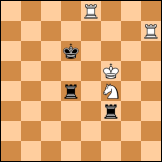 The demolition job isn't yet complete. 41.Rh7 f5+ 42.Kh4 g5+ 43.Kxg5 Rxg3+ 44.Kxf5 Rf3 finishes the job (right). Will can handle the threat to his knight with 45.Re6+, 45.Rd8+ or 45.Rh4.
The demolition job isn't yet complete. 41.Rh7 f5+ 42.Kh4 g5+ 43.Kxg5 Rxg3+ 44.Kxf5 Rf3 finishes the job (right). Will can handle the threat to his knight with 45.Re6+, 45.Rd8+ or 45.Rh4.41...Ke5 42.Rxd4
The rook trade takes much of the oomph out of Will's attack.
42...Kxd4 43.Rh7??
Without its partner, Will's remaining rook needs to be reassigned to pawn protection duty, because in a moment, his king won't be available to handle it.
43...f5+! 44.Kh4 g5+ 45.Kxg5 Rxg3+ 46.Kxf5+ Rf3
The same pattern as in the move 41 variation, with one big difference: each player is missing a rook. It's the difference between a white win and a draw.
47.Rd7+ Ke3 48.Rd3+ Kf2 49.Rd2+ Ke3 50.Re2+ Kd4 51.Kg4 Re3 52.Ne6+ Kd3 53.Nf4+ Ke4 54.Rd2 Ra3 ½-½
Will retains an infinitesimal edge, but it's worth nothing as long as Steve continues to play accurately. He concedes the draw.


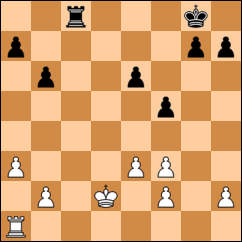
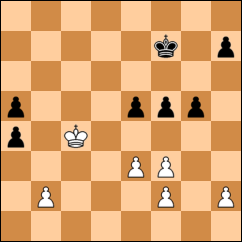
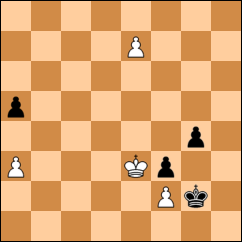
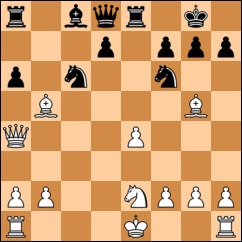
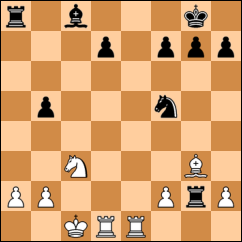
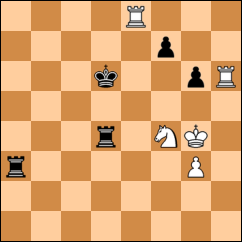
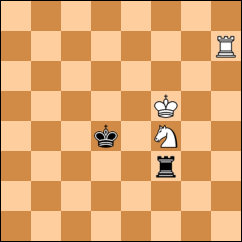



0 comments:
Post a Comment